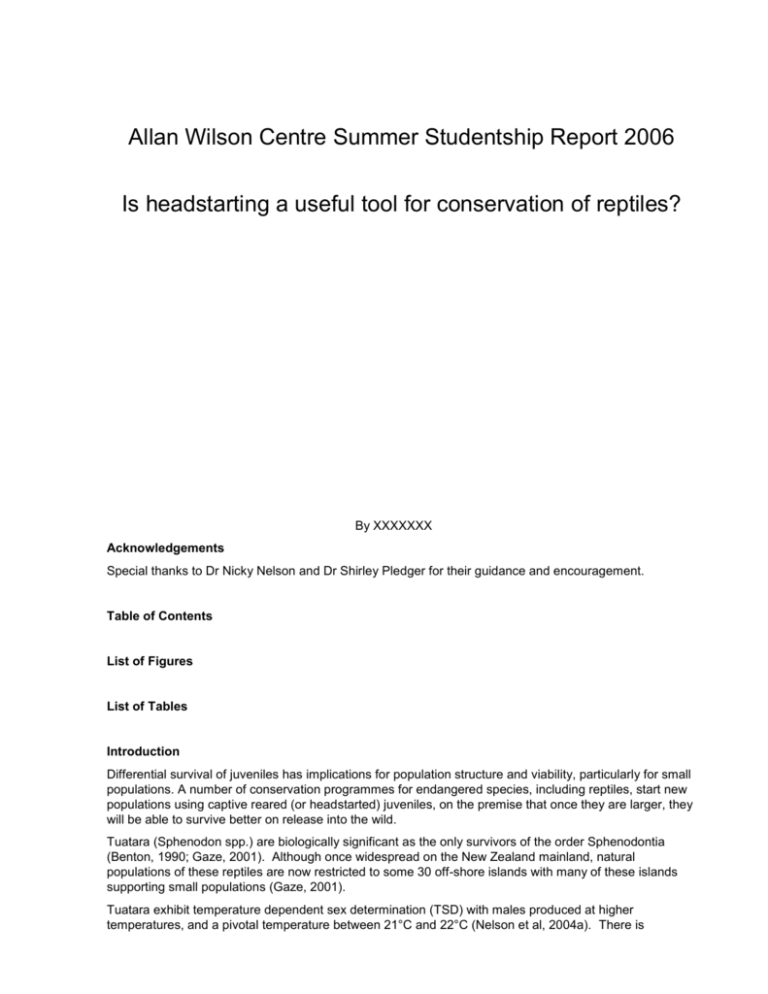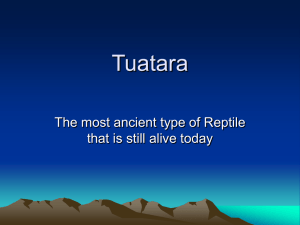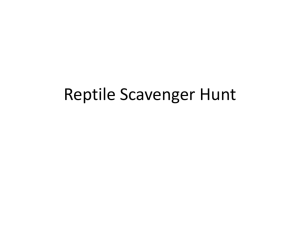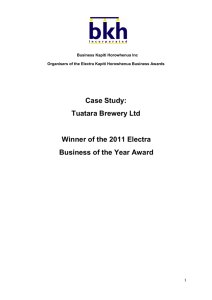Allan Wilson Centre Summer Studentship
advertisement

Allan Wilson Centre Summer Studentship Report 2006 Is headstarting a useful tool for conservation of reptiles? By XXXXXXX Acknowledgements Special thanks to Dr Nicky Nelson and Dr Shirley Pledger for their guidance and encouragement. Table of Contents List of Figures List of Tables Introduction Differential survival of juveniles has implications for population structure and viability, particularly for small populations. A number of conservation programmes for endangered species, including reptiles, start new populations using captive reared (or headstarted) juveniles, on the premise that once they are larger, they will be able to survive better on release into the wild. Tuatara (Sphenodon spp.) are biologically significant as the only survivors of the order Sphenodontia (Benton, 1990; Gaze, 2001). Although once widespread on the New Zealand mainland, natural populations of these reptiles are now restricted to some 30 off-shore islands with many of these islands supporting small populations (Gaze, 2001). Tuatara exhibit temperature dependent sex determination (TSD) with males produced at higher temperatures, and a pivotal temperature between 21°C and 22°C (Nelson et al, 2004a). There is evidence of the vulnerability of populations of tuatara to the effects of global warming because of TSD, with adult sex ratios showing a male bias in the small North Brother Island population (Nelson et al, 2002; Nelson et al, 2004b), and hatchling sex ratio in the Stephens Island population showing a male bias in warmer years (Nelson, unpublished data). Modification of sex ratios due to differential survival between males and females subsequent to hatching is not well understood. It is also problematic to investigate the survival of juveniles in the wild, due to their low capture probability (Dawbin, 1982). Project Scope The scope of this project was to collate and analyse data on survival and growth of juvenile tuatara raised in captivity at Victoria University for 1 year post hatching and subsequently at Nga Manu Nature Reserve, until release into the wild on Whakaterepapanui Island in Cook Strait at five years of age. The study animals included individuals incubated in natural nests and those that had been artificially incubated in temperature controlled conditions. The aims of the analysis were to investigate: mortality with respect to incubation conditions; growth with respect to sexual dimorphism and incubation conditions. Summary of main statistical analyses The subjects were divided into six fixed groups based on their incubation temperature and sex (Table 1). For all statistical tests, significance level was 0.05. Planned comparisons were conducted of differences between groups. Survival Logit models programmed into the R statistical package were used to investigate odds of survival with respect to incubation conditions and sex. Two periods were analysed separately: 1 month post hatching to translocation to Whakaterepapanui (5 years), using snout-vent length (SVL), weight and condition (log of weight / log of SVL) at one month post hatching as covariates; Time spent at Nga Manu (4 years), using SVL at transfer to Nga Manu as a covariate. Growth Growth at Nga Manu was analysed for individuals that survived to translocation. Using the R statistical program, ANCOVA was used to compare increase in SVL and weight and improvement in condition. Initial covariate values were measurements at transfer to Nga Manu. Summary of main results Survival Number of animals in the study and percentages surviving five years are outlined in Table 1. Group Id. Description Initial number at 1 month post hatching Survivors at 5 years Percent surviving f18 Females incubated at 18 deg. C 104 73 70.2% f21 Females incubated at 21 deg. C 75 58 77.3 % m21 Males incubated at 21 deg. C 3 1 33.3% m22 Males incubated at 22 deg. C 109 85 77.9% fvar Females from natural nests 50 33 66% mvar Males from natural nests 86 78 90.7% Total 428 328 77% Odds of survival differed between groups and between periods modelled (Figure 1). For the entire 5 year period (Figure 1a): heavier animals at one month post hatching had higher odds of surviving five years (p<0.001); males from natural nests had significantly higher odds of surviving than females from natural nests (p=0.000116); there were no other significant differences between groups. For the period at Nga Manu: longer animals had higher odds of surviving to translocation (p<0.001); individuals from natural nests were significantly more likely to survive than other groups (p<0.001); females from natural nests were significantly more likely to survive than females from temperature controlled incubation conditions (p=0.0313); males from natural nests were more likely to survive than males from artificial conditions (p<0.001); males from natural nests were more likely to survive than females from natural nests (p<0.001). between groups for the periods: a) entire 5 years; b) 4 years at Nga Manu. Odds of survival adjusted by average: a) weight and b) SVL. The large standard error for the m21 group is due to this group having only 3 individuals. Growth Change in weight, SVL and condition between groups showed very similar patterns. For example, Figure 2 shows trends in SVL. Males from natural nests grew significantly more than other groups for all measurements. There were no significant differences between other groups. Sexual dimorphism is evident in the individuals from natural nests, with males growing significantly more than females. Sexual dimorphism is not apparent between the males and females of the temperature controlled groups. Growth trends at Nga Manu. The m21 group is excluded for clarity due to extreme standard errors caused by small group size. Conclusions Implications for headstarting Larger individuals had better odds of survival than smaller individuals, which is in agreement with the premises of headstarting. However, because little is known about juvenile tuatara growth and survival in nature, the results of this study cannot be directly compared to wild populations. Because artificially incubated males had lower odds of survival than those from natural nests for both periods modelled, in the long term these animals may lack fitness when released into the wild. Implications for population viability If the results regarding differential survival of males and females from natural nests are reflected in small tuatara populations in the wild, adult sex ratios may be biased, contributing to population decline. In addition, possible aggression effects as found in other male-biased reptile populations may further decrease female fitness and contribute to decline and extinction of small populations (Le Galliard et al. 2005). Further study on how these juveniles progress now they have been released onto Whakaterepapanui Island, and how results might differ between tuatara populations and species will help shed more light on these areas. Outputs Conference presentations (presenting author underlined): Gruber, Monica, Shirley Pledger, Susan N. Keall, Charles H. Daugherty, Nicola J. Nelson. 2006. Evidence of differential survival between sexes in juvenile tuatara and possible effects on long term population viability. Australian Society of Herpetologists Conference in Healesville, Victoria. 18 – 21 April 2006. Gruber, Monica, Shirley Pledger, Susan N. Keall, Charles H. Daugherty, Nicola J. Nelson. 2006. Do artificially incubated tuatara (Reptilia) survive and grow as well as those incubated naturally. Society for Conservation Biology 20th Annual Meeting (Conservation without borders) in San Jose California. 24 – 28 June 2006 Journal Article: Gruber, Monica, Shirley Pledger, Susan N. Keall, Charles H. Daugherty, Nicola J. Nelson. (in prep.) Evidence of differential survival between sexes in juvenile tuatara and possible effects on long term population viability. References Benton, M.J. 1990. Vertebrate Palaeontology: Biology and Evolution. Harper Collins Academic Dawbin, W. H. 1982. The tuatara, Sphenodon punctatus: aspects of life history, growth and longevity. In New Zealand Herpetology, ed. D. G. Newman. New Zealand Wildlife Service. Wellington Gaze, P. 2001. Tuatara recovery plan 2001-2011. Threatened Species Recovery Plan 47. Department of Conservation Le Galliard, J-F., Fitze, P.S., Ferriers, R., Clobert, J. 2005. Sex ratio bias, male aggression, and population collapse in lizards. Proceedings of the National Academy of Sciences. 102.50: 18231-18236 Nelson, N. J., Keall, S. N., Pledger, S., Daugherty, C. H. 2002. Male-biased sex ratio in a small tuatara population. Journal of Biogeography. 29:633-640 Nelson, N. J., Thompson, M. B., Pledger, S., Keall, S. N., Daugherty, C. H. 2004a. Egg mass influences hatchling size, and incubation temperature influences post-hatching growth, of tuatara Sphenodon punctatus. Journal of Zoology, London 263:77-87 Nelson, N. J., Thompson, M. B., Pledger, S., Keall, S. N., Daugherty, C. H. 2004b. Do TSD, sex ratios, and nest characteristics influence the vulnerability of tuatara to global warming? International Congress Series. 1275:250-257











